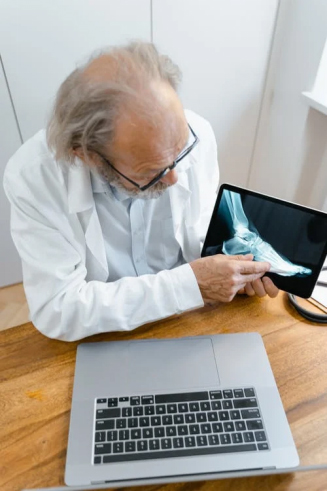Telemedicine: The New Age of Health Care

The term "telemedicine" (also known as telehealth) is the provision of medical services via telecommunication and information technology. It's an alternative to traditional in-person health care and is often used to supplement it. This may include obtaining medical information, diagnosis, and treatment from an online doctor using electronic data transmissions.
With the increased use of devices like smartphones and intelligent home assistants, it's safe to say telemedicine is the future of healthcare. From an android to a diagnosing chatbot, telemedicine doctor are using new technology and innovative ways to care for their patients.
Using Telemedicine To Treat A Variety of Health Concerns
The use of telemedicine in the United States is widespread, with over 20% of physicians using electronic visit systems and approximately 30% of hospitals offering some form of telehealth services. Telemedicine has been growing rapidly, with its usage expected to reach $6 billion by the end of 2023 and $25 billion by 2030.
Many people believe that telemedicine is only useful for treating non-severe illnesses like colds and flu. However, that is not true; telemedicine can be used to treat a number of health issues such as diabetes, cardiac, renal, and pulmonary issues, depression, substance abuse problems, and behavioral issues.
According to the American Telemedicine Association (ATA), telemedicine can be used to treat many different medical conditions, including problems related to:
- Cardiology, pulmonary, renal medicine
- Endocrinology/diabetes
- Nutrition
- Family medicine/gynecology/pediatrics
- Internal medicine
- Oncology and hematology
- Transplantation
- Orthopedics
- Neurology/neurosurgery
- Complementary medicine and alternative therapies such as chiropractic or acupuncture are also part of telemedicine services.

How AI and Telemedicine are Changing Healthcare
In the last several years, artificial intelligence (AI) has become more prevalent, and with it, AI-assisted diagnoses and treatment decisions. Medical practitioners make use of advanced technologies like machine learning, virtual assistance, and predictive analytics to improve patient outcomes, quality, and cost.
AI doesn't just help with quick diagnosis and management, but it also helps reduce the number of patient readmissions, reduce clinician burnout and enhance hospital operations. Tiny wearable devices can be used to monitor heart rhythms, monitor blood pressure, and even track a patient's gait. Virtual doctor visits in a secure video room are becoming more common. Prescriptions can be ordered, and refills can be requested through the internet.
Future of Telemedicine with AI
By using AI to enhance virtual care options, telemedicine doctors in the future can create a more personalized care experience for patients and improve health outcomes. Here's how:
- AI will allow healthcare providers to leverage their existing infrastructure and clinical capabilities while expanding their ability to meet the needs and expectations of their patients.
- AI will significantly improve the ability of virtual doctors to serve the increasing number of consumers with complex and chronic conditions as they face greater economic pressures, including higher deductibles and co-pays.
- AI will promote collaboration among providers for the purpose of learning and institutional strengthening.
- It will also provide healthcare providers with insights that help them improve operational efficiency and eliminate waste.
There is still a lot of work to be done as regulatory restrictions remain in place, but the potential for AI to revolutionize medicine prevails.
Benefits of Advancements in Telemedicine
The guide by NCBI mentions that telemedicine had grown from humble beginnings in the mid-1990s to become an increasingly important part of the health care industry. It's increasing popularity in the United States is because of the following reasons:
1. Cost savings
Telemedicine allows patients to avoid unnecessary emergency room visits and costly in-patient hospital stays. It also decreases out-of-pocket costs for patients by eliminating travel expenses and lost wages. One study found that telehealth services can save total costs for COVID-19 patients by 7%.
Telemedicine also provides access to qualified specialists without requiring them to relocate. A study published in the Journal of Medical Internet Research claims that telemedicine has the potential to save $20 billion annually. This is because, with telemedicine, there are fewer doctor visits, prescriptions, and tests done in-office.
Overall, telemedicine helps both patients and hospitals save money.

2. Saves Time
A virtual doctor visit via secure messaging or video conferencing is just as effective as a face-to-face visit with a healthcare provider. Patients don't have to drive to their appointment, wait for the doctor and then drive back home. And because virtual visits can be scheduled more quickly than in-person visits—sometimes within 24 hours—patients don't have to worry about missing work or taking a day off from school to get treatment.
Even the response to the COVID-19 crisis and its subsequent spread accelerated the growth of telemedicine. Telemedicine helped provide patients with access to online COVID-19 doctors while maintaining a low-cost and scalable solution.
3. Improved Health Care Access
Remote areas are often underserved when it comes to access to healthcare. The distance involved and the cost of procuring care can make getting treatment difficult for the residents. The Centers for Disease Control and Prevention (CDC) reported that people who live in rural areas of the U.S. are at a higher risk of dying prematurely from one of the leading causes of death, including cardiac disease, unintentional injury, cancer, chronic fever, hemorrhage, and respiratory disease.
For the millions of Americans who live without access to a medical facility, telemedicine is making great strides toward filling in the gaps for their medical care. It allows patients to receive medical treatment and care remotely from an online doctor without having to travel to a centralized location. Telemedicine also comes into play when a patient cannot access local medical services for reasons including medical emergency, natural disaster, or traveling abroad. It's also a convenient option for patients homebound due to a disability.

4. Fewer Interruptions During Patient Examinations and Consultations
Many medical consultations and examinations require a patient to disrobe in front of an unfamiliar doctor. This can be very uncomfortable for a young or older adult, who is more likely to be embarrassed by having their body examined.
Telemedicine aims to reduce this problem by allowing patients to get their examinations conducted remotely. Telemedicine doctors use cameras and other equipment to transmit images and video of a patient over the internet. A virtual doctor can then examine these images as if they were right beside the patient.
If you are looking to avail telemedical services, contact TelMDCare. We’re America’s leading virtual healthcare providers and house a team of professional online doctors who specialize in treating all kinds of health conditions for uninsured clients as well.
Book a virtual healthcare appointment now for as low as $35. Get in touch with our team of experts today to learn more about services for health treatments.